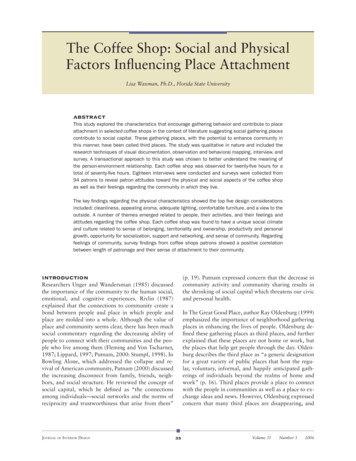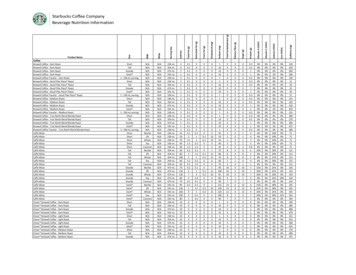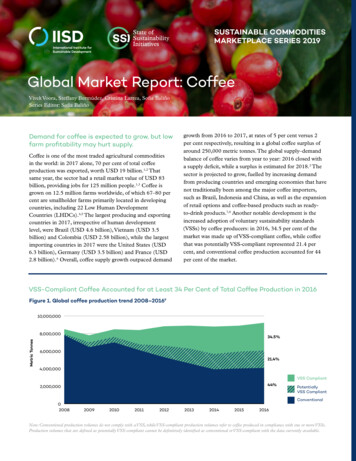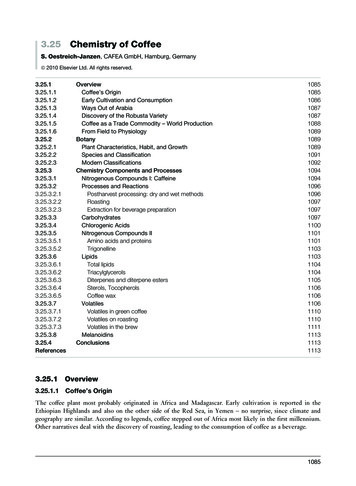
Transcription
The Coffee Shop: Social and PhysicalFactors Influencing Place AttachmentLisa Waxman, Ph.D., Florida State UniversityAbstractThis study explored the characteristics that encourage gathering behavior and contribute to placeattachment in selected coffee shops in the context of literature suggesting social gathering placescontribute to social capital. These gathering places, with the potential to enhance community inthis manner, have been called third places. The study was qualitative in nature and included theresearch techniques of visual documentation, observation and behavioral mapping, interview, andsurvey. A transactional approach to this study was chosen to better understand the meaning ofthe person-environment relationship. Each coffee shop was observed for twenty-five hours for atotal of seventy-five hours. Eighteen interviews were conducted and surveys were collected from94 patrons to reveal patron attitudes toward the physical and social aspects of the coffee shopas well as their feelings regarding the community in which they live.The key findings regarding the physical characteristics showed the top five design considerationsincluded: cleanliness, appealing aroma, adequate lighting, comfortable furniture, and a view to theoutside. A number of themes emerged related to people, their activities, and their feelings andattitudes regarding the coffee shop. Each coffee shop was found to have a unique social climateand culture related to sense of belonging, territoriality and ownership, productivity and personalgrowth, opportunity for socialization, support and networking, and sense of community. Regardingfeelings of community, survey findings from coffee shops patrons showed a positive correlationbetween length of patronage and their sense of attachment to their community.Introduction(p. 19). Putnam expressed concern that the decrease incommunity activity and community sharing results inthe shrinking of social capital which threatens our civicand personal health.Researchers Unger and Wandersman (1985) discussedthe importance of the community to the human social,emotional, and cognitive experiences. Rivlin (1987)explained that the connections to community create abond between people and place in which people andplace are molded into a whole. Although the value ofplace and community seems clear, there has been muchsocial commentary regarding the decreasing ability ofpeople to connect with their communities and the people who live among them (Fleming and Von Tscharner,1987; Lippard, 1997; Putnam, 2000: Stumpf, 1998). InBowling Alone, which addressed the collapse and revival of American community, Putnam (2000) discussedthe increasing disconnect from family, friends, neighbors, and social structure. He reviewed the concept ofsocial capital, which he defined as “the connectionsamong individuals—social networks and the norms ofreciprocity and trustworthiness that arise from them”Journal of Interior DesignIn The Great Good Place, author Ray Oldenburg (1999)emphasized the importance of neighborhood gatheringplaces in enhancing the lives of people. Oldenburg defined these gathering places as third places, and furtherexplained that these places are not home or work, butthe places that help get people through the day. Oldenburg describes the third place as “a generic designationfor a great variety of public places that host the regular, voluntary, informal, and happily anticipated gatherings of individuals beyond the realms of home andwork” (p. 16). Third places provide a place to connectwith the people in communities as well as a place to exchange ideas and news. However, Oldenburg expressedconcern that many third places are disappearing, and35Volume 31Number 32006
The Coffee Shop: Social and Physical Factors Influencing Place AttachmentWaxmanThe experience of place is unique to each individual and is directlyrelated to his or her lived experiences. Attachment to place is a setof feelings that emotionally binds people to a particular place.that in the United States, the third place has becomea distant third. He raised the question of how this decrease in the availability of community gathering placesimpacts the lives of people. What are the consequenceswhen communities lack places to gather with neighbors, friends, and to mingle with the familiar strangerswho hold the potential for new friendships, relationships, and ultimately the growth of the social capital ina community?This research on place and place attachment points tothe value of place in the lives of people. This paper willexpand on this research by exploring the variables thatcontribute to gathering behavior and place attachmentin third places, specifically coffee shops. The sites chosen for study included three selected coffee shops in amid-size city in the southeastern United States. The purpose of this study was to see what qualities, both physical and social, encourage people to gather in those coffee shops and develop an attachment to those places.Oldenburg (1999) explained that most third placesdraw their identity from the beverages they serve. Historically, coffee houses have provided places for socialintercourse and conversation, as well as political debate(Pendergrast, 1999). They have also served as placeswhere people could gather, speak freely, and mingle withothers from their communities (Oldenburg, 1999). Formany people, the coffee shop serves as a third place, aplace to regularly interact with fellow community members. In the United States, from 2000 to 2004, fast foodchains grew at a rate of 2% per year, while coffee shopchains grew more than 10% annually (Holmes, 2004).In 2004, forty-two percent of adults in the United Statesaged 18-34 purchased their coffee at a coffee shop with48% consuming the beverage on the premises. Thesenumbers seem to indicate that the coffee shop is aboutmore than just coffee; perhaps the place in which it isconsumed has significance in itself.Literature ReviewDue to the availability of literature on the social/psychological studies of place, and a lack of literature onthe design of social gathering places, this review of literature will focus primarily on studies of place and placeattachment.The experience of place is unique to each individual andis directly related to his or her lived experiences. Attachment to place is a set of feelings that emotionally bindspeople to a particular place. “Places root us—to theearth, to our own history and memories, to our familiesand larger community” (Cooper-Marcus & Frances,1998, p. xi). Understanding the concept of place provides an important framework for understanding theway people form relationships with places.When relationships develop between people and places,the result is often a feeling of place attachment. Low(1992) stated, “Place attachment is the symbolic relationship formed by people giving culturally sharedemotional/affective meanings to a particular space orpiece of land that provides the basis for the individual’sand group’s understanding of and relation to the environment” (p. 165). Proshansky, Fabian, and Kaminoff(1983) described place attachment as involving the interplay of emotions, knowledge, beliefs, and behaviorsin reference to a place.Scholars studying place attachment report that attachment to place comes about through a set of related phenomenon rather than a singular phenomenon (Low &Altman, 1992). In addition, a number of scholars haveviewed the concept of place attachment in a transactional framework involving psychological, social, and temporal experiences (Stokols & Shumaker, 1981; Brownand Perkins, 1992; Altman & Rogoff, 1987). A definition by Brown and Perkins (1992) states, “Place attachment involves positively experienced bonds, sometimesoccurring without awareness, that are developed overtime from the behavioral, affective, and cognitive tiesbetween individuals and/or groups and their sociophysical environment” (p. 284).Volume 31Number 32006Place attachment refers to the idea that people developspecial bonds with certain settings that hold deep meaning to the individual (Low & Altman, 1992). The word36Journal of Interior Design
The Coffee Shop: Social and Physical Factors Influencing Place AttachmentWaxmanPlace attachment has the potential to offer predictabilityin a daily routine, a place to relax from the more formal rolesof life, and the opportunity for control in various areas of life(Low & Altman, 1992).“attachment” refers to affect while the word “place” refers to the “environmental settings to which people areemotionally and culturally attached” (Low & Altman,1992, p. 5). Affect, emotion, and feeling are central tothe concept of place attachment and appear consistentlyin studies on this topic. Relph (1976) believed that tobe inside a place is to belong and identify with it. Tuan(1980) suggested the existence of a state of rootednessin which one’s personality merges with one’s place. Hewrote that the primary function of place is to engendera sense of belonging and attachment.Taylor (1983) propose a person-environment congruence model of place attachment. This model suggeststhat place attachment involves “expectations of stability, feelings of positive affect, greater knowledge of thelocale, and behaviors that serve to maintain or enhancethe location” (p. 237). This model includes the person’ssocial networks as a contributor to place attachment.The importance of social relationships that occur inplaces must not be overlooked and may enhance theactivity of people-place bonding (Chawla, 1992). Thesocial involvement of family, friends, community, andculture may be equally, or more important, than theplace alone (Cooper-Marcus, 1992). Altman and Low(1992) emphasized the importance of people in interpersonal, community, cultural, and social relationshipsthat are essential to place experiences. Crumpacker(1993) studied an elementary school that, after havingserved several generations, was to be torn down andreplaced. The purpose of her research was to better understand what made the school successful for so long.She found that the school provided much more thanan education to students. It provided a place to sharefolklore, establish relationships, provide support, andserved as a repository of memories for the community.Students and teachers reported a sense of belonging, ofbeing known to others, and of ownership.Traditional definitions of place attachment view it asan outcome, as feeling of being attached (Tuan, 1974).However, Harris, Brown, and Werner (1996) emphasized place attachment as both the feeling of being attached and the process of becoming attached, which include reasons for the attachment. Attachment to placeinvolves the assessment of the current setting, as well asthe assessment of the relative quality of alternative settings (Stokols & Shumaker, 1981). Higher quality environmental settings are those that support the goals andactivities of the person (Stokols and Shumaker, (1982).Stokols and Shumaker’s (1982) model of place attachment lists neighborhood, physical amenities, individualand household characteristics, and social networks asimportant components of place attachment. They explain that these components may relate to place attachment by influencing need, or how the environmentsmeets needs, such as neighborhood networks that fulfilla need for social support.Place attachment serves a number of functions for people and their culture. Place attachment has the potentialto offer predictability in a daily routine, a place to relaxfrom the more formal roles of life, and the opportunity for control in various areas of life (Low & Altman,1992). It also provides the opportunity to link withfriends and community in a visible and concrete way.The connection to history and to culture may occurthrough place or through symbols that are associatedwith places. Place then becomes part of the lived experience, an interwoven component of life experiences, andis inseparable from them. Low & Altman, 1992).Place attachment can be looked at in a transactionalperspective where place attachment is not composedof separate or independent parts, components, dimensions, or factors. The people and place interact togetherto form the experience. It is important to remember thatgroups, families, community members, and even entirecultures often collectively share attachment to variousplaces (Lawrence, 1992; Hummon, 1992). Rubinsteinand Parmelee (1992) suggested that life experienceshave an emotional quality that produce a bond with theplaces in which these experiences occur. Shumaker andJournal of Interior DesignTo successfully design spaces that serve as third placesand community gathering places, designers should un-37Volume 31Number 32006
The Coffee Shop: Social and Physical Factors Influencing Place AttachmentWaxmanThe focus on the transactional nature of the person-environmentalconnection required descriptions of the flow and dynamics of events.derstand the social and physical characteristics of placethat enhance the patron’s experience. By better understanding those components that contribute to positiveplace experiences, designers can create spaces that promote comfort, a sense of belonging, and a bond betweenpeople and place.nomenon of additional interest (Rivas, 2004; Holmes,2004)). The characteristics of the three coffee shops varied and included a large national chain, a locally ownedshop frequented by a variety of community members,and another locally owned coffee shop located near auniversity campus.PurposeVisual InstrumentationThe purpose of this study was to explore the physicaland social qualities that encouraged people to gather inthird places, specifically coffee shops, and develop anattachment to those places. Several supporting researchquestions were asked including:The study began with the collection of information onthe physical characteristics of the coffee shops includingthe location of the coffee shop, and the architecturaland design attributes of each coffee shop. The Architectural Features Checklist served as the instrument toframe the collection of these details. This checklist wasmodeled after the Physical and Architectural FeaturesChecklist developed by Moos and Lemke (1984). Thearchitectural features of the coffee shop exterior werenoted, as well as the location relative to major roads,the ability to walk from surrounding neighborhoods,access to nearby shops, parking availability, along withany other exterior or site considerations that were notable. The interior architecture, ceiling height, colors, finish materials, furniture type, access to natural lighting,type of artificial lighting, location of electrical outlets,views to the outside, views of spaces inside, availabilityof outside seating, ability to move furniture, availabilityof speakers for music or announcements, and any othernotable characteristics were recorded as well. Photographs of the exterior and the interior of each spacewere also taken and used as visual documentation.1. What characteristics and design featuresattract people and cause them to feel attachment to the coffee shops?2. What social interactions or human contacts attract people and cause them to feelattachment to the coffee shops?3. Is there a relationship between coffeeshop patronage and feelings of attachmentto community?Overview of the MethodologyThe mixed-design methodology selected for this research included the techniques of visual documentation, observation, interview, and survey. The focus onthe transactional nature of the person-environmentalconnection required descriptions of the flow and dynamics of events. It was important to note what peoplewere doing, thinking, behaving, and feeling as wellas the static and fixed conditions (Dewey and Bentley(1949). The goal was to discover the meaning of thespace to the participants (Eisner, 1998; Altman & Rogoff, 1987). The study took place in three coffee shopslocated in the Southeastern United States. Coffee shopswere chosen for two reasons. First the coffee shops metmany of the criteria of third places as defined by Oldenburg (1999), thereby allowing gathering and lingering behavior to be studied. In addition, the increase inthe number of coffee shops opening in communities inthe United States in the last ten years made this phe-Volume 31Number 32006Observation SessionsObservation sessions assisted in the understanding ofhow the coffee shops were used and how the design related to the activities that took place in the space. Priorto the observation sessions, floor plans were drawn andcopied for each coffee shop denoting walls, windows,doors, furniture placement, service areas, and anyother important permanent or semi-permanent designfeatures for use in accurately recording the people andactivities that took place in the space. Each of the threecoffee shops was observed for 25 hours each, for a totalfor 75 hours with care taken to observe on a variety of38Journal of Interior Design
The Coffee Shop: Social and Physical Factors Influencing Place AttachmentWaxmanThe survey included questions regarding the location of thecoffee shop, how they got to the coffee shop, their preferred seatlocation, various acoustic, lighting, and ambient conditions, theirsocialization habits in the coffee shop days and times. The researcher conducted all of the observation sessions, therefore inter-rater reliability wasnot an issue. The behavior of the patrons was documented with 862 patrons observed during the sessions.During each observation session, a copy of a floor planwas used to denote occupied seats. Detailed field notesoutlining the activities of the patrons were also recorded. Each patron was assigned a letter on the floor planwhich corresponded with the same letter noted in thefield notes. This allowed the floor plans and field notesto be further studied at a later date and the activitiesin the coffee shop reconstructed. All observation noteswere typed for use in coding the data with the corresponding floor plans attached for later use.The survey included questions regarding the location ofthe coffee shop, how they got to the coffee shop, theirpreferred seat location, various acoustic, lighting, andambient conditions, their socialization habits in the coffee shop, as well as questions on the design and décorfound in the coffee shops. Finally, there were severalopen-ended questions addressing participants’ feelingsabout the coffee shop and level of satisfaction with thecommunity in which they live.Interview SessionsTo further understand the coffee shop environment andthe meaning these coffee shops held for patrons, interviews were conducted. To get a variety of perspectives,18 interviews took place including 12 patron interviews,three employee interviews, and three interviews with theowner or manager of each coffee shop. These interviewswere divided evenly among the three coffee shops. Theinterviews took place in the coffee shops, lasted approximately 45 minutes and were recorded with notes transcribed for later use in the coding of the data.SurveyTo better understand the preferences of the patrons, surveys were distributed in each of the coffee shops. Ninety-four surveys were completed, 31 in two coffee shopsand 32 in another. The sample of survey respondentscan be considered a nonrandom purposive sample. Carewas taken to gather data at a variety of times during theday. In each of the three coffee shops, approximately 10survey participants were chosen in the morning, 10 during the middle of the day, and 10 in the evening. It wasconsidered important to survey patrons from varioustimes of day due to the varied social climate in the coffee shops during these different timeframes. Every person who entered the coffee shop during the designatedtime frame was asked to participate in the survey. Theresearcher had the full cooperation of the managementof each coffee shop. Of the 96 people asked to participate in the survey, only two declined to participate.AnalysisThe data derived from the observations and interviewswas analyzed qualitatively using coding techniquesoutlined by Strauss and Corbin (1998). Microanalysis,open coding, axial coding, selective coding methodswere used to examine the data. The coding began withmicroanalysis, sometimes referred to as line-by lineanalysis with lines, phrases, sentences, and paragraphsanalyzed. All of the field notes from the observation sessions, open-ended survey questions, and interview transcripts were examined line by line in search of uniqueevents involving the physical and social use of the coffee shops. This phase was followed by open coding, inwhich the data were broken down into discrete partsand compared for similarities and differences (Straussand Corbin, 1998). Physical and social events foundto be similar in nature or related in meaning weregrouped were grouped in categories. Many entries received more than one label because they fell into severalcategories. For example, the group of older men, whoarrived at the coffee shop every morning, and pulledThe survey had two parts and included both close-endedand open-ended questions. The first part of the surveyasked each patron to evaluate the characteristics of thecoffee shop they patronized while the second part askedwhat characteristics they would like to see in their idealcoffee shop. Questions were asked about characteristics of their ideal coffee shop, so the researcher couldidentify those attributes that were highly valued, andmay even be missing from the coffee shop they frequent.Journal of Interior Design39Volume 31Number 32006
The Coffee Shop: Social and Physical Factors Influencing Place AttachmentWaxmanThe survey data revealed the highest rated design andambient characteristics of each coffee shop, as well as those preferredin an ideal coffee shop.chairs together to talk would fall into coding categories related to their age, the way they modify the physical space, the fact that they socialized at length whiledrinking coffee, and were regular patrons. Notes fromthe interviews would also reveal that these men wereretired and still enjoyed getting up early and “havingto be somewhere.” While categories were assembled inthe open coding process, axial coding also took place(Strauss and Corbin, 1998). Open and axial coding arenot sequential events, but proceed naturally together.This phase allows the researcher to look for answersto questions such as why, where, when, how, and withwhat results (Strauss & Corbin, 1998). The last stageof coding is referred to as selective coding. This stageis the process of integrating and refining categories toform a larger theoretical scheme that eventually resultsin theory. From this process, four categories of findingsemerged. These included findings related to the physicalcharacteristics of the spaces, the social characteristics ofthe spaces, the people who patronized the spaces, andthe feelings and attitudes of the patrons regarding thecoffee shop and their community.tioned, the survey data was analyzed separately usingStatistical Package for Social Sciences software. Thissurvey data was analyzed using descriptive statistics,frequencies, and correlation analysis. The survey datarevealed the highest rated design and ambient characteristics of each coffee shop, as well as those preferredin an ideal coffee shop. Correlational analysis was usedto look at relationships between frequency of patronage, frequency of socialization, and satisfaction withlife in the community.FindingsThe findings will be broken down into the followingcategories: Characteristics of the coffee shops, characteristics of the patrons, and then each of the four research questions will be addressed and discussed.Characteristics of the Coffee Shops: Coffee Shop 1Coffee Shop 1 is a locally owned coffee shop near amajor university and frequented primarily by students.This coffee shop is housed in what was once an old autorepair garage. The original brick walls and garage doorcontribute to the character of the space. Half of the coffee shop is at ground level while the other half is raisedIn addition to the qualitative analysis previously men-Figure 1. Exterior View of Coffee Shop 1Volume 31Number 32006Figure 1. Interior View of Coffee Shop 140Journal of Interior Design
The Coffee Shop: Social and Physical Factors Influencing Place AttachmentWaxmanCorrelational analysis was used to look at relationships betweenfrequency of patronage, frequency of socialization, and satisfactionwith life in the community.up three feet. Seating is located on both levels and includes tall tables with bar stools, smaller round tableswith wooden chairs, one square table that seats four tosix. The coffee shop also has one old upholstered chairthat is very popular with patrons and is moved aboutas needed. The flooring is concrete, the walls are brick,and the lighting is primarily old refurbished chandeliers and track lighting. A long study bench that seats10 people runs along the top level. Natural light comesin through three windows and two doors and primarily located on the north, northeast, and northwest endsof the building. The dominant colors are those of thebrick walls, wooden furniture, and acid washed concrete flooring. The view outside includes a parking lotand major highway.bar and includes an eclectic mix of two-person tables, afuton sofa, and a few small upholstered chairs all purchased at second-hand stores. The floors are wood andcarpet. The space is home to a museum that serves theAmerican Legion Hall with photos of war planes andveterans. A piano sits near the entry and is often playedby patrons during the evening. Colors are predominantly warm with wood floors, brown carpet, and brownwooden and plastic chairs. Canvas coffee bags adornthe coffee service area. Christmas lights that were hungyears ago still adorn the service bar area. Local artistsdisplay work and the coffee shop holds art openings forthe artists as well. A bulletin board overflows with announcements of local activities. Natural light comes inthrough the south facing windows, but the entire coffeeshop is sheltered by two large live oak trees. In addition,this coffee shop overlooks a small lake popular withwalkers and joggers.Coffee Shop 2Coffee Shop 2 is a locally owned coffee shop located ina mid-town neighborhood and frequented by local residents who walk to the coffee shop, but also by a varietyof community members who drive to the coffee shop.This coffee shop is housed in the back of the AmericanLegion hall in what was once a storeroom. Seating islocated throughout the coffee shop and at the serviceCoffee Shop 3Coffee Shop 3, a large national chain coffee shop witha bookstore attached, is located on a busy intersection.This is the only one of the three to be designed specifically as a coffee shop. Many college students patronizeFigure 3. Exterior View of Coffee Shop 2Journal of Interior DesignFigure 4. Interior View of Coffee Shop 241Volume 31Number 32006
The Coffee Shop: Social and Physical Factors Influencing Place AttachmentWaxmanThe top five characteristics of the ideal coffee shop includedcleanliness, aroma, adequate lighting, comfortable furniture,and a view to the outside.this shop, but there are also patrons from a variety ofage groups. The seating in this space is uniform with themajority of the rectangular tables seating two people.The tables are wooden with laminate tops while thechairs are wooden with vinyl seat covers. A leather sofa,two large leather chairs, and a large round table are alsoavailable. Flooring is ceramic tile. Colors are predominately warm with yellow walls, wood surrounding thecoffee service area, and wooden tables and chairs. Localart is hung on several walls. Natural light pours in fromthe south and west facing windows. The view includesa parking lot, a view of the drug store next door, and amajor highway.fell between some college and a bachelor’s degree, whichwas not surprising in a college town (See Table 1).Findings Relatedto the Research QuestionsResearch Question 1: What physical characteristics anddesign features attract people and cause them to feel attachment to the coffee shop.Physical Design Characteristic RatingsThe survey included questions on the preferred designand ambient characteristics of the coffee shop respondents currently patronized. In addition, patrons wereasked what design and ambient characteristics theywould value most in their ideal coffee shop (see Table 2).They were asked about their ideal coffee shop becauseinterviews and casual discussions revealed most patronshad suggestions on how their current coffee shop couldbe improved. Therefore the survey asked patrons to ratethose characteristics they felt were most important andwould like to see included in their ideal coffee shop.Characteristics of the PatronsTable 1 illustrates the demographic characteristics ofthe 862 coffee shop patrons observed in this study. Themean age of the coffee shop patrons was 30. It is interesting to note that two of the three coffee shops had agreater percentage of male patrons, with Coffee Shop1, the former auto repair garage, having 59% male patrons. Another characteristic of note is the larger number of minority patrons (25%) in Coffee Shop 3, thelarge national chain coffee shop. The educational levelThe top five characteristics of the ideal coffee shop included cleanliness, aroma, adequate lighting, comfort-Figure 5. Exterior View of Coffee Shop 3Volume 31Number 32006Figure 6. Interior View of Coffee Shop 342Journal of Interior Design
The Coffee Shop: Social and Physical Factors Influencing Place AttachmentWaxmanTable 1. Demographic Characteristics of the Coffee Shop Patronsable furniture, and a viewto the outside.CoffeeShopCoffeeShop 1n 228CoffeeShop 2n 228CoffeeShop 3n %82%9%3%4%OtherMinority1%Cleanliness. Cleanlinesswas listed as the most3254%46%91%6%1%1%1%important factor in the
the cOffee shOp: sOciaL and physicaL factOrs infLuencing pLace attachment Waxman The experience of place is unique to each individual and is directly related to his or her lived exp





![[Ringle Material] 3rd wave coffee (Philz Coffee and Blue .](/img/22/2592b1ca.jpg)





